Aquaponics brings fish and vegetables together in a symbiotic growing process. The fish produce nutrients that are used by the vegetables in a virtuous circle. The result is high-density food production that can be done at scales from the kitchen table to industrial warehouses. It works well in urban spaces that are otherwise difficult to farm.
We’re building two things:
- An aquaponics control system – the nerve center – based on low-cost computing (Pi and Arduino), home-brew or commercial sensing and bespoke control equipment.
- A community of people – a monkey space :-) – sharing data and knowledge about their aquaponics systems, what grows best, how to increase yields and decrease energy usage and the like.
We’re building open source and open hardware. Our goals are:
- To increase local food production. The more we produce locally the less we have to ship around the world (producing carbon emissions), and the more resilience we have to survive supply chain breakdowns.
- Help connect the aquaponics community. People work best when they cooperate and share knowledge – that’s where language comes from, for example – and there’s plenty to know about hydroponics, aquaculture, how the two work together and how to control them.
The prototype nerve center is part of Incredible Edible Todmorden’s Aqua Garden. 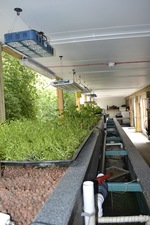
Quoting from the system documentation:
We have designed and built a system to take measurements from the aquaponics installation, log them and also display them over the internet. The system can also control a valve to allow the plant bed to be watered.
You can see the live data as it is collected by visiting the system dashboard here. If you want to download the data in a spreadsheet then you can click here.
The system has lots of sensors, an Arduino micro-controller to gather the measurements, a Raspberry Pi computer to control the system, and relays to control the valve.
We’ve written software for both the Arduino and Raspberry Pi, and these programs work together to monitor and control the system.
We are excited to have delivered an advanced aquaponics system that does more than commercial systems costing many thousands of pounds. Needless to say we didn’t have that sort of budget!
We’ve been able to quickly deliver so much functionality at such a low cost by leveraging the enormous amount of work that’s already been done and then freely shared by other talented engineers across the world. To find out more about this sharing system (open source) click here. Our software can be freely downloaded here and the hardware designs here.
The aquaponics system has 13 sensors connected to an Arduino micro-controller. The Arduino has many different expansion possibilities and it can be easily connected to other individual electronic components. It’s job is to connect to the sensors and read each one in turn.
The Arduino is connected to an expansion ‘shield’ to extend the number of sensors it can read.
The expansion board has extra circuitry on it to amplify the tiny signals produced by the pH probe, the ORP probe and the EC probe.
At the heart of the aquaponics control system is a Raspberry Pi.
The Raspberry Pi is a credit card sized computer that is designed and built in the UK. It runs the control software system and sends video and data to the internet.
The Raspberry Pi has an expansion connector that is used to drive a custom built board for the webcam lights and the solenoids that control the valve between the tanks.
The software running on the Arduino and the Raspberry Pi together make the system work. The code for the Arduino is written in a language called Wiring that is based on C++:
for (int i = 0; i < 1000; i++) { total = total + (.0264 * analogRead(pin) -13.51) / 1000; delay(1); }
The control software uses a very different system that represents the flow of messages through the system visually.
To program the system, blank ‘nodes’ (the ovals) are dropped onto the page and then customised. The nodes of the program are then connected up and the messages follow the lines.
Systems like this are often called event-driven, because the system reacts to events as they occur, rather than run through a series of instructions.
There are more details and a system overview at Layer Zero Labs.
A Growing Movement
We’re not the only ones! Lots of new aquaponics projects have sprung up recently (often bootstrapped with crowdfunding).
For example, the EcoQube from Adiventures 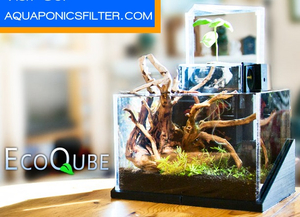 is a gorgeous “desktop ecosystem that uses basil to filter water, to showcase firsthand the practical solution and beauty of aquaponics”. The EcoQube was funded on Kickstarter in January 2014. “We want to start a movement to use the same concept of sustainable agriculture to feed the world! We know that we can’t solve the many problems on our planet with an aquarium, no matter how beautiful it is, but we hope to connect people to our environment and influence the way they perceive the larger issues in our world today.” They say that “aquaponics grows food 30-50% faster with far less space, less pests and 90% less water” and ask “WHY do we need pesticides in our vegetables, antibiotics and hormones in our fish?! And whatever we don’t consume, flush it out into the rivers and oceans?” They have produced a good set of teaching and learning materials including an activity book.
is a gorgeous “desktop ecosystem that uses basil to filter water, to showcase firsthand the practical solution and beauty of aquaponics”. The EcoQube was funded on Kickstarter in January 2014. “We want to start a movement to use the same concept of sustainable agriculture to feed the world! We know that we can’t solve the many problems on our planet with an aquarium, no matter how beautiful it is, but we hope to connect people to our environment and influence the way they perceive the larger issues in our world today.” They say that “aquaponics grows food 30-50% faster with far less space, less pests and 90% less water” and ask “WHY do we need pesticides in our vegetables, antibiotics and hormones in our fish?! And whatever we don’t consume, flush it out into the rivers and oceans?” They have produced a good set of teaching and learning materials including an activity book.
Back to the Roots have built the AquaFarm, a “closed-loop ecosystem – fish feed the plants, plants clean the water” that also fits on the kitchen table. The AquaFarm was funded on Kickstarter in 2012.
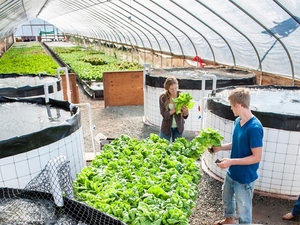 The Farming Fish project “project is all about forward motion and improvement! Our mission is simple: to practice agriculture in the most wholesome ways – nurturing the lands that we ask to feed us while developing Aquaponics. We are not only certified Organic but practice the most sustainable farming methods known today. The Farming Fish is a leader in the growing field of commercial Aquaponics. With a one quarter acre greenhouse, we are the largest organic aquaponics farm in the US. Our farm is pretty amazing, we’re showing every day, bringing Organic Aquaponic food to market, that resources can be better utilized and preserved for future generations. We grow a variety of leafy vegetables and superfoods, most sold living for highest nutritional value and shelf life, and the most sustainable seafood products out there.” The Farming Fish was funded on Kickstarter in September 2014.
The Farming Fish project “project is all about forward motion and improvement! Our mission is simple: to practice agriculture in the most wholesome ways – nurturing the lands that we ask to feed us while developing Aquaponics. We are not only certified Organic but practice the most sustainable farming methods known today. The Farming Fish is a leader in the growing field of commercial Aquaponics. With a one quarter acre greenhouse, we are the largest organic aquaponics farm in the US. Our farm is pretty amazing, we’re showing every day, bringing Organic Aquaponic food to market, that resources can be better utilized and preserved for future generations. We grow a variety of leafy vegetables and superfoods, most sold living for highest nutritional value and shelf life, and the most sustainable seafood products out there.” The Farming Fish was funded on Kickstarter in September 2014.
From Sustainability to Resilience
Have you noticed how scientists used to talk about sustainability but now they talk about resilience? (Sustainability is about ways to organise our lives so that we will not run out of resources or melt the ice caps. Resilience is our capacity to withstand shocks and changes.) Why? 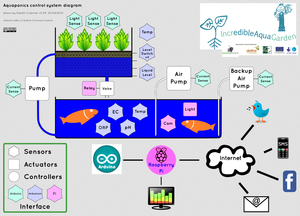
It has become more and more obvious that digging up trillions of tons of grungey carbon-rich gunk and burning it all is going to change things a wee little here and there. So we all started looking for sustainable paths to take – and many have been found. The tricky thing is that there’s no short-term profit in saving the planet. Now climate change is accelerating and our market-driven system has no mechanism to respond.
What to do?
Many things, but one of them is to build resilience.
A society is resilient if it can supply its needs (e.g. for food, shelter or health) without relying on systems outside of its control.
A society is less likely to be resilient if it relies on shipping large parts of its needs half way around the world. We are vulnerable to disruption brought by war, or the chaotic weather systems brought by climate change, or the volatile price of oil.
Local food production is more resilient in face of all types of glitches in our food supply chains. Strong communities are more resilient in all types of ways: if you know your neighbours, and their skills and resources, you know where to go in a crisis!
Want to join in? Contact us.
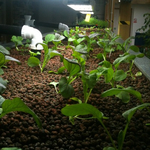
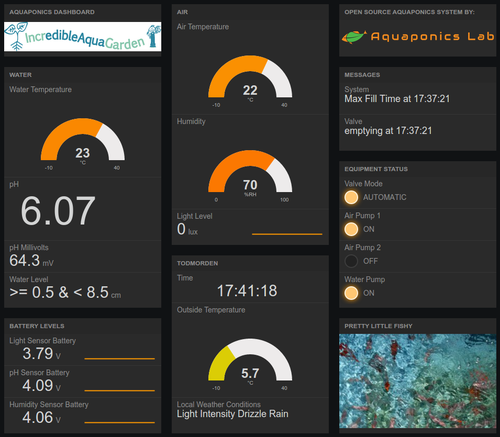
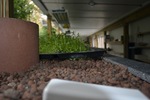

Comments
comments powered by Disqus